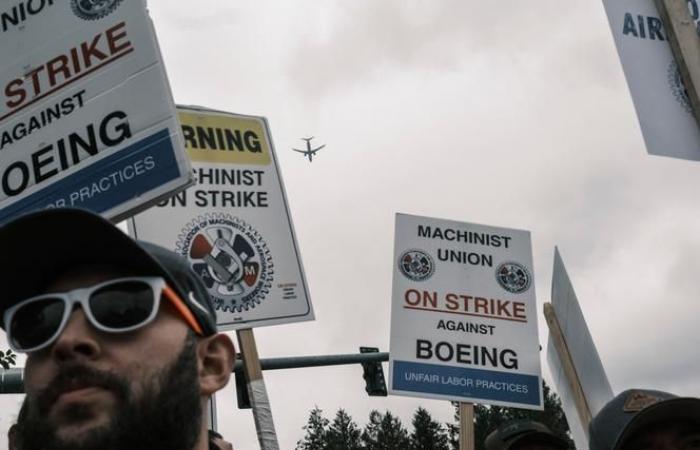Technical difficulties on the 737 MAX and the long-haul 777X, hiccups in the supply chain, setbacks in space, ruinous defense contracts, a delay of several years in the delivery of the two 747- 8 presidential Air Force Ones, a debt of 58 billion dollars (53 billion euros) and an unprecedented strike since that of 2008: Boeing is going through the most dangerous zone of turbulence since its creation in 1916. And it is now chasing liquidity – without its survival really being at stake.
After announcing, Friday, October 11, the elimination of 17,000 jobs (10% of its workforce), the American aircraft manufacturer announced, Tuesday, October 15, that it will raise up to 25 billion dollars (debt, capital) to give yourself “flexibility” et “support the company’s balance sheet over a three-year period”. To this will be added a credit line of 10 billion dollars subscribed to Citigroup, Goldman Sachs, Bank of America and JP Morgan Chase. Enough to reassure Wall Street a little – the stock has lost 42% since the 1is January – which expects, on October 23, the publication of poor results for the third quarter.
The new CEO of Boeing, Kelly Ortberg, in office since August after the accelerated ousting of Dave Calhoun, has a social emergency: to find a way out of the strike, since September 13, of the 33,000 employees of the Everett and Renton (Washington), which notably assembles 777s, 787 Dreamliners and 737s. Followed by an overwhelming majority of employees, who demand salary increases of 40%, it is entering its second month and has already cost some 3 billion dollars.
Read also | Article reserved for our subscribers Should you be afraid of flying on a Boeing plane?
Add to your selections
Boeing’s difficulties began well before with the two successive accidents of its new medium-haul 737 MAX, in October 2018 and March 2019, which caused the death of 346 passengers and crew members. “It all started at the turn of the 2000s, when Boeing saw Airbus arriving as a real competitor”explains a former aeronautics boss, on condition of anonymity. Until then, the Seattle aircraft manufacturer, which had bought its American competitor McDonnell Douglas in 1996, believed itself to have no real rival. And he embarked on a policy where profitability took precedence over security.
Bill for the two crashes
To maintain its leadership, Boeing also decided to abandon fully integrated production to copy the more fragmented Airbus model. “He broke his model, sold factories to manufacture his long-haul 787 Dreamliner. And it didn’t work! »remembers the former captain of industry. His problems continued “when Boeing was unable to decide whether to launch a successor to the 737, designed in the 1960s, or to re-engine it”he notes. “American Airlines had to say to the manufacturer: “We have ordered 150 Airbus A320neo. If you don’t decide within forty-eight hours, we’ll order 150 more.”the leader still remembers. But, he continues, “Boeing’s biggest mistake was to follow the example of Airbus and re-engine its 737, when its plane no longer had any potential for development”.
You have 50.23% of this article left to read. The rest is reserved for subscribers.







